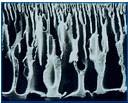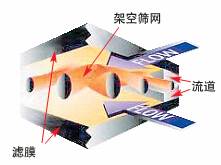Pall offers industry-leading tangential flow filtration (TFF) technology to meet the diverse needs of diverse biotechnology and bioprocesses and address challenges. These products are designed to streamline the process and streamline the process while ensuring consistent filtration and maximum filtration.
Tangential flow ultrafiltration (TFF) can quickly and efficiently separate and purify biomolecules; it can be used for concentration and desalination of sample solutions as low as 10 ml up to several thousand liters; it can also be used for biomolecules of different sizes. Isolation, collection of cell suspensions, and clarification of fermentation broth and cell lysates.
Why use tangential flow ultrafiltration
â— Easy to assemble and easy to operate - Simply connect the tangential flow ultrafiltration unit, pump and pressure gauge with piping and a few piping fittings, and add samples to the tank to start working.
â— Fast and efficient - contrast dialysis, easier assembly and faster processing; compared to centrifugal concentrating devices or agitated ultrafiltration devices, higher concentrations can be obtained in a shorter time.
â— Only need to perform two steps in the same system - complete sample concentration and diafiltration in the same system, saving time and avoiding loss of product.
• Process and scaling – Laboratory-scale conditions can be applied to production-scale applications due to structural materials and flat-type ultrafilter fluid paths. A corresponding tangential flow ultrafiltration unit can be provided for processing samples as low as 10 mL, or up to a kiloliter volume. Low cost - The tangential flow ultrafiltration unit and the flat ultrafiltration unit can be reused after cleaning or can be disposed of after a single application. A simple integrity test can be performed to verify the integrity of the filter and seal.
The principle of tangential flow ultrafiltration? How to separate biomolecules
In tangential flow (also known as "cross-flow") ultrafiltration, the pump pushes fluid through the surface of the membrane and washes away the molecules trapped on it, thereby minimizing fouling on the surface of the membrane. The pressure in the retentate fluid that abuts the filter membrane causes the solute and small molecules to pass through the filter membrane. This will complete the filtering. The use of a subdivision screen to separate sand and pebbles from simulations helps to understand the mechanism of tangential flow ultrafiltration: the mesh eye symbolizes the pores on the filter, while the sand and pebbles symbolize the molecules to be separated, in DC filtration, sand - The cobblestone mixture is forced to move towards the screen mesh, and as some of the smaller sand passes through the screen mesh, a cobblestone layer is formed on the surface of the screen, preventing the top sand from moving toward the screen and passing through the mesh (Fig. 1). In DC filtration, the pressure is increased and only the pressure can be applied to the mixture without contributing to the promotion of separation; in contrast, in the tangential flow ultrafiltration mode, the formation of the confinement layer is prevented by the recirculation of the mixture, again The cycle is similar to: vibrating to remove the pebbles that block the mesh, causing the sand on top of the mixture to fall through the mesh. Therefore, the use of tangential flow ultrafiltration for biomolecule separation is more efficient, and the concentration or washing speed is faster.

figure 1
Separating sand and pebbles with a subdivided screen
(A) Applying direct pressure to the mixture to cause the bottom sand to fall; forming a cobblestone layer on the surface of the screen, preventing the top sand from moving toward the screen and passing through the screen. (B) Vibrating screen, destroying the accumulated cobblestone layer at the bottom of the mixture, so that complete separation can be carried out; in the tangential flow filtration, the cross-flow dynamics of the inlet stream is equivalent to the vibration in this example.
Main application of tangential flow ultrafiltration
Tangential flow ultrafiltration is mainly used for: concentration, washing (desalting and buffer replacement) and separation of biomolecules by size. In addition, it can also be used for the removal and clarification of cells and cell debris in fermentation broth or cell culture fluid.
Filter selection
Pall Life Science offers a wide range of membranes to address the challenges of molecular separation with superior performance and stability. The distinguishing features of Pall's products are derived from these universal filters:
Ultrafiltration membrane
Based on the principle of pore size, ultrafiltration can be used to separate particularly small particles and dissolved molecules. In any type of device, the performance of the ultrafiltration membrane is determined by its morphology. The ultrafiltration membrane has an asymmetric structure (see picture above) such that particles larger than the molecular weight cut-off of the membrane are trapped at the surface of the membrane while allowing smaller material to pass through the substructure of the membrane. If the surface of the filter is extremely smooth, the interception yield of biomolecules and viruses will increase. Due to the lower structure of the membrane, the particles are rapidly transferred, delaminated from the ultrafiltration membrane, and prevented from fouling.
Ultrafiltration membrane package flow path selection
Mesh flow channel In this mesh flow path configuration, the screen creates a gentle turbulent flow in the filtrate fluid, minimizing filter fouling. The mesh flow path has been applied to filter a 0.2 μm grade solution (free of particulate matter or polymer that can block the screen). | Overhead screen runner In the return path, the suspended screen fluid path configuration has a more open structure and performs better when handling viscous or particulate matter-intensive solutions. |
| |
Mesh flow path: Optimize the protein solution without particles | Overhead runners: Selecting overhead runners for solutions with mild to moderate granules |
Determine the appropriate product based on the starting sample volume

Choose the right molecular weight cut-off
Depending on the goal of ultrafiltration, the membrane pore size chosen is usually 3 to 6 times smaller than the relevant molecule that needs to remain in solution, and is 3 to 6 times larger than one molecule in the solution to ensure that the molecule can pass through the membrane. .
More information: Pall-cut flow ultrafiltration system manual
Mechanical Heat Meters
At present, the heat metering market commonly used heat table is divided into mechanical heat meter(mechanical heat metering) and ultrasonic heat meter.The mechanical heat
meters is consist of temperature sensor, flow sensor and calculator. With the
aid of the temperature sensor, The mechanical Heat Meters measure the inlet
water and return water temperature. Flow rate sensor measures the volume rate
of the hot water in the tube trough the time difference. The figures recorded
will be delivered to integral calculator which calculates the total heat and
displays.
The mechanical heat meters
sensors measures the flow rate through the circles of the wheels. According to
the specification, The DN can be ≤40mm
and ≥50mm. According to the inner structure, the small size mechanical heat
meters can be single jet and multi jet. At present, our mechanical heat meters
belong to single jet mechanical heat meters and they have higher request from
the water quality. According to the counter of the flow sensor,
the mechanical heat meters can be dry and wet type. Our mechanical heat meters
are the dry type.Except mechanical heat
meters,the plastic heat meter is also a good product.
Mechanical Heat Meters,Mechanical Heat Energy Meter,Mechanical Digital Meters,Mechanical Heat Metering,Plastic Heat Meter
Berggruen Technology Co.,Ltd , https://www.meter-technology.com





